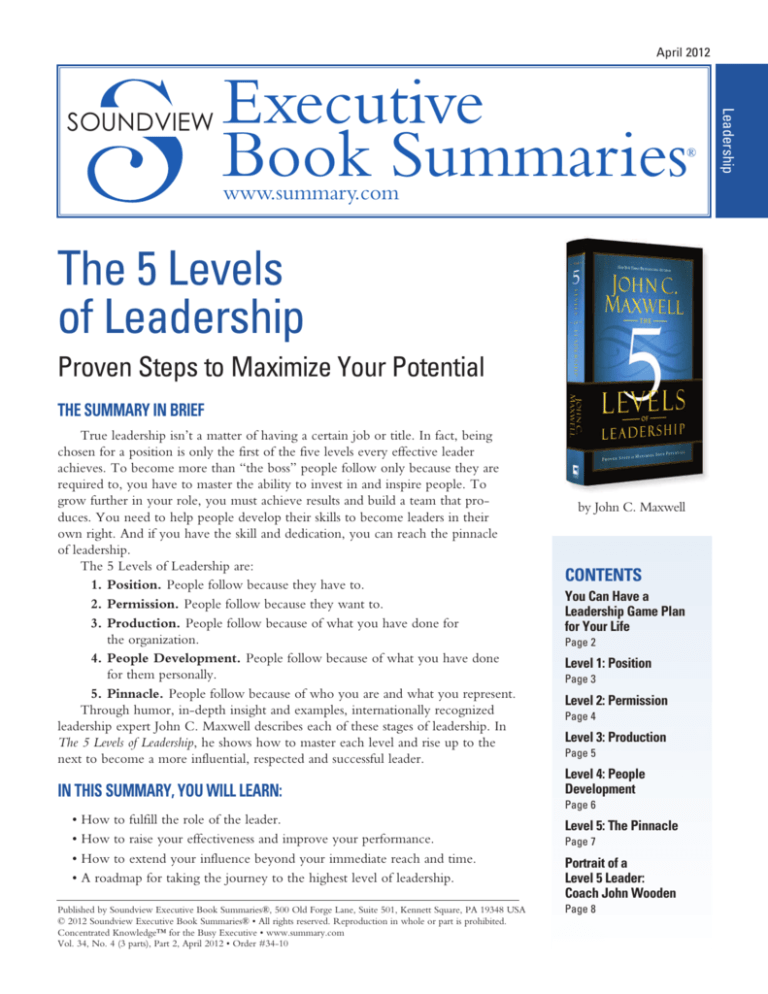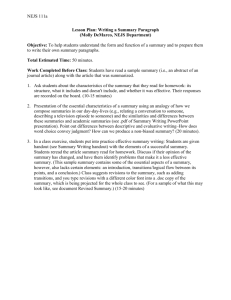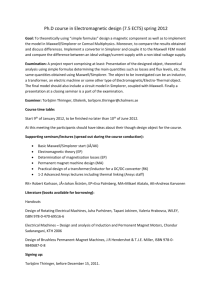
April 2012
Executive
Book Summaries
®
www.summary.com
The 5 Levels
of Leadership
Proven Steps to Maximize Your Potential
THE SUMMARY IN BRIEF
True leadership isn’t a matter of having a certain job or title. In fact, being
chosen for a position is only the first of the five levels every effective leader
achieves. To become more than “the boss” people follow only because they are
required to, you have to master the ability to invest in and inspire people. To
grow further in your role, you must achieve results and build a team that produces. You need to help people develop their skills to become leaders in their
own right. And if you have the skill and dedication, you can reach the pinnacle
of leadership.
The 5 Levels of Leadership are:
1. Position. People follow because they have to.
2. Permission. People follow because they want to.
3. Production. People follow because of what you have done for
the organization.
4. People Development. People follow because of what you have done
for them personally.
5. Pinnacle. People follow because of who you are and what you represent.
Through humor, in-depth insight and examples, internationally recognized
leadership expert John C. Maxwell describes each of these stages of leadership. In
The 5 Levels of Leadership, he shows how to master each level and rise up to the
next to become a more influential, respected and successful leader.
IN THIS SUMMARY, YOU WILL LEARN:
by John C. Maxwell
CONTENTS
You Can Have a
Leadership Game Plan
for Your Life
Page 2
Level 1: Position
Page 3
Level 2: Permission
Page 4
Level 3: Production
Page 5
Level 4: People
Development
Page 6
•
•
•
•
How to fulfill the role of the leader.
How to raise your effectiveness and improve your performance.
How to extend your influence beyond your immediate reach and time.
A roadmap for taking the journey to the highest level of leadership.
Published by Soundview Executive Book Summaries®, 500 Old Forge Lane, Suite 501, Kennett Square, PA 19348 USA
© 2012 Soundview Executive Book Summaries® • All rights reserved. Reproduction in whole or part is prohibited.
Concentrated Knowledge™ for the Busy Executive • www.summary.com
Vol. 34, No. 4 (3 parts), Part 2, April 2012 • Order #34-10
Level 5: The Pinnacle
Page 7
Portrait of a
Level 5 Leader:
Coach John Wooden
Page 8
Leadership
SOUNDVIEW
THE COMPLETE SUMMARY: THE 5 LEVELS OF LEADERSHIP
by John C. Maxwell
The author: John C. Maxwell is an internationally respected leadership expert, speaker and author who has sold more than
20 million books. Maxwell is the founder of EQUIP, a nonprofit organization that has trained more than 5 million leaders in
126 countries worldwide. Maxwell has written three books that have sold more than a million copies: The 21 Irrefutable Laws of
Leadership, Developing the Leader Within You and The 21 Indispensable Qualities of a Leader.
The 5 Levels of Leadership: Proven Steps to Maximize Your Potential by John C. Maxwell. Copyright © 2011 by John C.
Maxwell. Summarized by permission of the publisher, Center Street, a division of Hachette Book Group, Inc. 289 pages, $25.99.
ISBN: 978-1-59995-365-6. To purchase this book, go to www.amazon.com or www.bn.com.
Summary copyright © 2012 by Soundview Executive Book Summaries® www.summary.com, 1-800-SUMMARY.
For additional information on the author, go to www.summary.com or JohnMaxwellOnLeadership.com.
You Can Have a Leadership Game
Plan for Your Life
In all the years that I’ve taught about leadership, there
has been one lecture that I have been asked to give
more often than any other — from West Point to
Microsoft and in countries all around the world. That
lecture explains how leadership works, and it provides a
game plan for learning how to become a leader. It’s
“The 5 Levels of Leadership.”
You Can Learn Practical Leadership Tools
The 5 Levels has been used to train leaders in companies of every size and configuration, from small businesses to Fortune 100 companies. It has been used to help
nonprofit organizations understand how to lead volunteers. And it’s been taught in more than 120 countries
around the world. Every time I talk about it, people ask
questions and make observations. Those things have
helped the 5 Levels of Leadership become stronger and
develop greater depth. The concept is tested and
proven. In addition, it offers several other benefits:
• The 5 Levels of Leadership Provides a Clear
Picture of Leadership. How do people get a handle
on leadership? For those who are not naturally gifted for
it, leadership can be a mystery. For them, leading people
is like walking down a dark corridor. They have a sense
of where they want to go, but they can’t see ahead, and
they don’t know where the problems and pitfalls are
going to lie. For many people in the academic world,
leadership is a theoretical exercise, an equation whose
variables are worthy of research, study and rigorous
debate. In contrast, the 5 Levels of Leadership is visually
straightforward, so anyone can learn it.
1-800-SUMMARY
• The 5 Levels of Leadership Defines Leading as
a Verb, Not a Noun. Leadership is a process, not a
position. Leadership deals with people and their dynamics, which are continually changing. They are never static. The challenge of leadership is to create change and
facilitate growth. Those require movement, which, as
you will soon see, is inherent in moving up from one
level of leadership to the next.
• The 5 Levels of Leadership Breaks Down
Leading into Understandable Steps. The subject of
leadership can be overwhelming and confusing. Where
does leadership start? What should we do first? What
processes should we use? How can we gain influence
with others? How can we develop a productive team?
How do we help followers become leaders in their own
right? The 5 Levels of Leadership gives answers to these
questions using understandable steps.
• The 5 Levels of Leadership Provides a Clear
Game Plan for Leadership Development. Good
leadership isn’t about advancing yourself. It’s about
advancing your team. The 5 Levels of Leadership provides clear steps for leadership growth. Lead people well
and help members of your team become effective leaders,
and a successful career path is almost guaranteed.
• The 5 Levels of Leadership Aligns Leadership
Practices, Principles and Values. When I developed
the 5 Levels, I conceived of each level as a practice that
could be used to lead more effectively. As time went by
and I used and taught the levels, I realized they were actually principles. Here’s the difference: A practice is an
action that may work in one situation but not necessarily
in another. A principle is an external truth that is as reliable as a physical law. For example, when Solomon said,
Published by Soundview Executive Book Summaries® (ISSN 0747-2196), 500 Old Forge Lane, Suite 501, Kennett Square,
PA 19348 USA, a division of Concentrated Knowledge Corp. Published monthly. Subscriptions starting at $99 per year.
service@summary.com Copyright © 2012 by Soundview Executive Book Summaries ®.
Available formats: Summaries are available in several digital formats. To subscribe, call us at 1-800-SUMMARY (240-912-7513 outside the United States), or order online
at www.summary.com. Multiple-subscription discounts and corporate site licenses are also available.
Rebecca S. Clement, Publisher; Sarah T. Dayton, Editor in Chief; Andrew Clancy, Senior Editor; Chris Lauer, Contributing Editor; Amanda Langen, Graphic Designer
2 Soundview Executive Book Summaries® www.summary.com
Summary: THE 5 LEVELS OF LEADERSHIP
“A gentle answer turns away every wrath, but a harsh
word stirs up anger,” he stated a principle that is universal
and timeless.
Principles are important because they function like a
map, allowing us to make wise decisions. If we embrace a
principle and internalize it, it becomes a part of our values.
The 5 Levels influences my leadership life every day. ●
Level 1: Position
Leadership traditionally begins with Position.
Someone joins the Army, and he or she becomes a
recruit, working to earn the rank of private. A person
gets a job, and along with it comes a title or job description: laborer, salesperson, waiter, clerk, accountant,
manager. Position is the starting place for every level of
leadership. It is the bottom floor and the foundation
upon which leadership must be built. Real influence
must be developed upon that foundation.
There was a time when people relied heavily on position to lead, which is no surprise when you consider
that at one time, hereditary leadership positions were
handed down from father to son (and sometimes daughter) within families. Princes became kings and their decisions were law — for good or bad. In most industrialized nations, those days are gone. True, there are still
nations with kings and queens, but even in most of
those nations, such as England, monarchs rule with the
permission of the people, and the real leaders are usually
elected. Position gives you a chance, but it usually carries with it very little real power, except in systems
where the penalties for not following are dire.
There’s nothing wrong with having a position of leadership. When a person receives a leadership position, it’s
usually because someone in authority saw talent and
potential in that person. And with that title and position
come some rights and a degree of authority to lead others.
Position is a good starting place. And like every level
of leadership, it has its upsides and downsides.
The Upside of Position
Just as there are positive and negative aspects in every
season of life, there are both positive and negative aspects
to every level of leadership. If you are new to leadership
and you receive a position, then there are things to celebrate. Here are four of them:
1. A Leadership Position Is Usually Given to
People Because They Have Leadership Potential.
Most of the time when people enter a leadership position, they do so because it was granted or appointed by
some other person in authority. That probably seems
obvious. But think about the implications: It usually
means that the person in authority believes that the new
leader has some degree of potential for leading. That’s
good news. So if you’re new to leadership and you have
been invited to lead something, then celebrate the fact
that someone in authority believes in you.
If you have a new leadership position, then welcome
to the first step in your leadership journey. You have a
seat at the table and have been invited to be part of the
“leadership game.” You will have opportunities to
express your opinion and make decisions.
Your initial goal should be to show your leader and your
team that you deserve the position you have received.
2. A Leadership Position Means Authority Is
Recognized. When an individual receives a position
and title, some level of authority or power usually comes
with them. Often, in the beginning, that power is very
limited, but that’s OK because most leaders need to
prove themselves with little before being given much.
As the Infantryman’s Journal (1954) says, “No man is a
leader until his appointment is ratified in the minds and
the hearts of his men.”
As a new leader, you must use the authority you are
given wisely, to advance the team and help the people
you lead. Do that and your people will begin to give
you even greater authority. When that happens, you
gain leadership, not just a position.
3. A Leadership Position Is an Invitation to
Grow as a Leader. There should always be a relationship between receiving a leadership position and fulfilling the requirements demanded by it. One of the main
requirements is personal growth. I learned this early in
my life from my father, who loved to quote, “To whoever much is given, much shall be required.” He
believed that each of us had received a lot in life, and
we had a responsibility to learn and grow so that we
could make the most of it.
The journey through the 5 Levels of Leadership will
only be successful if you dedicate yourself to continual
development. If you believe that the position makes the
leader, you will have a hard time becoming a good leader.
4. A Leadership Position Allows Potential
Leaders to Shape and Define Their Leadership.
The greatest upside potential for people invited to take a
leadership position is that it affords them the opportunity
to decide what kind of leader they want to be. The
position they receive may be defined, but they are not.
When you first become a leader, your leadership page
is blank and you get to fill it in any way you want!
What kind of leader do you want to be? Don’t just
www.summary.com Soundview Executive Book Summaries® 3
Summary: THE 5 LEVELS OF LEADERSHIP
become reactive and develop a style by default. Really
think about it. Do you want to be a tyrant or a team
builder? Do you want to come down on people or lift
them up? Do you want to give orders or ask questions?
You can develop whatever style you want as long as it is
consistent with who you are.
As you think about the way you will define your leadership, take into consideration what kinds of habits and
systems you will consistently practice. What will you do
every day when you arrive at work? How will you treat
people? What will be your work ethic? What kind of
example will you set? Everything is up for grabs. It’s up
to you to define it. And the earlier you are on the leadership journey, the greater the potential for gain if you
start developing good habits now.
The bottom line is that an invitation to lead people is
an invitation to make a difference. Good leadership
changes individual lives. It forms teams. It builds organizations. It impacts communities. It has the potential to
impact the world. But never forget that position is only
the starting point. ●
Five Downsides of Position
Since Position is the lowest level of leadership, it
has a great number of negatives. Here are five:
1. Having a Leadership Position Is Often
Misleading. Once you have a position or title, people will identify you with it. However, positions and
titles are very misleading. A position always promises more than it can deliver.
2. Leaders Who Rely on Position to Lead Often
Devalue People. As a result, departments, teams or
organizations that have positional leaders suffer terrible morale.
3. Positional Leaders Feed on Politics. When
leaders value position over the ability to influence
others, the environment of the organization usually
becomes very political. Positional leaders focus on
control instead of contribution.
4. Positional Leaders Place Rights Over
Responsibilities. Inevitably, positional leaders
expect their people to serve them, rather than looking for ways to serve their people. This does nothing
to promote teamwork or create a positive
working environment.
5. Positional Leadership Is Often Lonely. If you’re
atop the hill alone, you may get lonely. If you have
others alongside you, it’s hard to be that way.
Level 2: Permission
Making the shift from Position to Permission brings a
person’s first real step into leadership. Why do I say that?
Because leadership is influence, nothing more, nothing
less. Leaders who rely on their positions to move people
rarely develop influence with them. If their subordinates
do what they are asked, it’s usually because they think
they have to — to receive their pay, keep their jobs,
prevent being reprimanded and so on.
In contrast, when a leader learns to function on the
Permission level, everything changes. People do more
than merely comply with orders. They actually start to
follow. And they do so because they really want to. Why?
Because the leader begins to influence people with relationship, not just position. Building relationships develops
a foundation for effectively leading others. It also starts to
break down organizational silos as people connect across
the lines between their job descriptions or departments.
The more barriers come down and relationships deepen,
the broader the foundation for leading others becomes.
When people feel liked, cared for, included, valued
and trusted, they begin to work together with their
leader and each other. And that can change the entire
working environment. The old saying is really true:
People go along with leaders they get along with.
Moving up to Level 2 is an important development in
leadership because that is where followers give their
supervisors permission to lead them. People change from
being subordinates to followers for the first time, and
that means there is movement! Remember, leadership
always means that people are going somewhere. They
aren’t static. No journey, no leadership.
Best Behaviors on Level 2
If you find yourself in a place where you need to start
working to win people’s permission on Level 2, what
should you do? How can you make the most of the
opportunity to develop as a relational leader? Do
the following:
1. Connect with Yourself Before Trying to
Connect with Others. One of the secrets of connecting with people and building relationships is knowing
and liking yourself. In my book Winning With People, I
call it the Mirror Principle, which says, “The first person
we must examine is ourselves.” The work in relationship building always has to start with yourself.
2. Develop a People-Oriented Leadership Style.
Permissional leaders don’t rely on rules to lead people.
They don’t depend on systems. And they never try to
rule with a stick. (Anyone who does needs to know that
4 Soundview Executive Book Summaries® www.summary.com
Summary: THE 5 LEVELS OF LEADERSHIP
every stick eventually breaks.) Instead, they use a personal touch whenever they deal with people. They listen, learn and then lead. They develop relationships.
They have more than an open-door policy — they
know the door swings both ways. They go through it
and get out among their people to connect.
3. Practice the Golden Rule. I always teach the
golden rule: “Treat others as you want others to treat
you.” It is a core teaching that can be found in every
culture and religion. It is the simplest, most profound
and most positive guide to living there is. Practicing the
golden rule enables everyone to feel respected.
4. Become the Chief Encourager of Your
Team. For many years I have enjoyed the friendship of
the Cathy family, the leaders of Chick-fil-A. One day
when I was having dinner with Truett Cathy, the company’s founder, he said, “Do you know how I identify
someone who needs encouragement? If the person is
breathing they need a pat on the back!”
5. Strike a Balance Between Care and Candor. I
believe that people can change their attitudes and can
improve their abilities. And because I do, I talk to them
about where they’re coming up short. If you’re a leader
and you want to help people, you need to be willing to
have those tough conversations. Care without candor
creates dysfunctional relationships. Candor without care
creates distant relationships. But care balanced with candor creates developing relationships. ●
Level 3: Production
The Production level is where leadership really takes
off and shifts into another gear. Production qualifies and
separates true leaders from people who merely occupy
leadership positions. Good leaders always make things
happen. They get results. They can make a significant
impact on an organization. Not only are they productive
No One Can Fake Level 3
No one can fake Level 3. Either you’re producing
for the organization and adding to its bottom line
(whatever that may be), or you’re not. Thomas
Watson, the founder of IBM, noted, “The outstanding leaders of every age are those who set up their
own quotas and constantly exceed them.” That is a
good description of Level 3 leaders. They are selfmotivated and productive. As a result, they create
momentum and develop an environment of success,
which makes the team better and stronger.
individually, but they also are able to help the team produce. This ability gives Level 3 leaders confidence, credibility and increased influence.
Another benefit of leadership on Level 3 is that it
attracts other highly productive people. Producers are
attractive to other producers. They respect one another.
They enjoy collaborating. They get things done together. That ultimately creates growth for the organization.
Leaders can get to Level 1 for an almost endless number of reasons: They show promise; they have connections; they play politics; they have seniority; the organization is desperate. You name it and someone has probably received a leadership position because of it. Leaders
who are naturally good with people or who take pains
to learn people skills can move up to Level 2. But some
people never move up from Level 2 Permission to Level
3 Production. Why? They can’t seem to produce results.
When that’s the case, it’s usually because they lack the
self-discipline, work ethic, organization or skills to be
productive. However, if you desire to go to higher levels of leadership, you simply have to produce. There is
no other way around it.
The Laws of Leadership at the Production Level
If you want to use the Laws of Leadership to help you
grow on Level 3, then consider the following:
• The Law of Respect: People Naturally Follow
Leaders Stronger Than Themselves. When you’re working to gain relational credibility on Level 2, the positive
results are often intangibles, such as morale and trust. In
contrast, the results of good leadership are highly tangible at Level 3. People see better organization, increased
productivity and higher profitability. The result is that
they see your strengths and understand what you can do.
Your credibility is established. People respect that and
they follow not only because you treat people well, but
because of what you do for the team and organization.
• The Law of Magnetism: Who You Are Is Who
You Attract. When you reach Level 3 and create a highly productive team, you begin to attract other producers.
The great thing about this is that it helps you make the
productive team you’ve developed even more productive. Introducing additional highly productive people to
the team raises the bar and makes everyone more productive. And if there are people on the team who won’t
or can’t produce, others will be lined up at your door
willing to take their place.
• The Law of the Picture: People Do What People
See. Leaders are usually highly visible to the people they
lead, especially if they lead by going first. As a result,
their actions are always noticed. If you’re a producer,
www.summary.com Soundview Executive Book Summaries® 5
Summary: THE 5 LEVELS OF LEADERSHIP
that’s a good thing. Nothing motivates people in a positive way more than seeing a positive leadership model.
When people see results from their leaders, they know
results are expected from them. And whenever results
are an expectation, greater productivity happens.
• The Law of Victory: Leaders Find a Way for the
Team to Win. The best leaders on Level 3 find ways to
win. They always do. They produce! If you are one of
those people who consistently produces, then everyone
will want to be on your team. That makes leading that
much better.
• The Law of the Big Mo: Momentum Is a
Leader’s Best Friend. Level 3 is where momentum kicks
in. Good results create momentum. Having momentum
gives you greater results. Greater results create even
more momentum. With momentum, an organization
can overcome problems, negativism, past issues, pettiness
and upcoming obstacles.
• The Law of Priorities: Leaders Understand That
Activity Is Not Necessarily Accomplishment. Level 3
leaders do the right things the right way at the right time
for the right reasons. They know that an organization
where anything goes eventually becomes a company
where nothing goes. They plan and act accordingly.
• The Law of Sacrifice: A Leader Must Give Up to
Go Up. Radio broadcaster Paul Harvey remarked, “You
can tell you’re on the road to success; it’s uphill all the
way.” You’ll have to give up some privileges and
resources to move up. Leaders learn to let go of everything but the essentials as they climb.
• The Law of Buy-In: People Buy into the Leader,
Then the Vision. The buy-in comes from the relationships
you have with them and the results you demonstrate in
front of them. They want to know you care about them
and they want to know you can produce. ●
Level 4: People Development
Effective leaders understand that what got them to
their current level of leadership won’t be enough to get
them to the next one. They understand that if they want
to keep getting better as leaders, they have to be willing
to keep growing and changing, and that each move up
the 5 Levels of Leadership requires a paradigm shift and
a change in the way a person leads.
On Level 3, the emphasis is on personal and corporate
productivity. The ability to create a high-productivity
team, department or organization indicates a higher level
of leadership ability than most others display. But to
reach the upper levels of leadership that create elite
organizations, leaders must transition from producers to
developers. Why? Because people are any organization’s
most appreciable asset.
Good leaders on Level 4 invest their time, energy,
money and thinking into growing others as leaders. They
look at every person and try to gauge their potential to
grow and lead — regardless of the individual’s title, position, age or experience. Every person is a potential candidate for development. This practice of identifying and
developing people compounds the positives of their
organization because bringing out the best in a person is
often a catalyst for bringing out the best in the team.
Developing one person for leadership and success lays the
foundation for developing others for success.
Bringing Out the Best in the Team
In On the Profession of Management Peter Drucker observed:
Making the right people decisions is the ultimate
means of controlling an organization well. Such
decisions reveal how competent management is,
what its values are and whether it takes its job
seriously. No matter how hard managers try to
keep their decisions a secret — and some still try
hard — people decisions cannot be hidden. They
are eminently visible. Executives who do not
make the effort to get their people decisions right
do more than risk poor performance. They risk
losing their organization’s respect.
How does this emphasis on people and people decisions translate into action? Leaders on the People
Development level of leadership shift their focus from
the production achieved by others to the development
of their potential. And they put only 20 percent of their
focus on their personal productivity while putting 80
percent of it on developing and leading others.
This can be a difficult shift for highly productive people who are used to getting their hands dirty, but it’s a
change that can revolutionize an organization and give it
a much brighter future.
Beliefs That Help a Leader Move Up to Level 5
If you have managed to move up to Level 4, you are
leading at a very high level, higher than 90 percent of all
other leaders. But there is still one level higher that may
be within your reach. Fewer than 1 percent of all leaders
achieve it. To prepare yourself to attempt that final
climb and give yourself the best chance of making it to
the top, you must first embrace the following beliefs:
1. The Highest Goal of Leadership Is to
Develop Leaders, Not Gain Followers or Do
Work. When you help other people become leaders,
you change their lives. You change the way they see the
6 Soundview Executive Book Summaries® www.summary.com
Summary: THE 5 LEVELS OF LEADERSHIP
world. You change their capacity. You increase their
potential. You change the way they interact with others.
If they become good leaders, you help them improve
not only their lives, but also the lives of everyone they
touch. I believe that is how you change the world for
the better.
2. To Develop Leaders, You Must Create a
Leadership Culture. You will not be able to move up
to Level 5 unless you create a leadership culture. Jim
Blanchard did this at Synovus. In an interview with
George Barna, Blanchard said, “I think the most important and difficult thing is to create a culture in the organization where leadership is really important. It’s important for people in the company to realize that this is a
growth-oriented company, and the biggest thing we
have to grow here is you, because it’s you who will
make this company better by your growth. ... So I
would think making a culture aware of the significance
of developing leaders is valuable.”
3. Developing Leaders Is a Life Commitment,
Not a Job Commitment. Level 4 leaders develop
people. Level 5 leaders consistently develop leaders over
a lifetime, and the leaders they raise up also develop leaders. It becomes a lifestyle they practice everywhere and at
all times, not a program they implement or a task they
occasionally practice. Mentoring is a mantle that they
wear willingly and they strive to add value to others. ●
Level 5: The Pinnacle
Rare is the leader who reaches Level 5 — the Pinnacle.
Not only is leadership at this level a culmination of leading well on the other four levels, but it also requires both
a high degree of skill and some amount of natural leadership ability.
It takes a lot to be able to develop other leaders so that
they reach Level 4; that’s what Level 5 leaders do. The
individuals who reach Level 5 lead so well for so long
that they create a legacy of leadership in the organization
they serve.
Pinnacle leaders stand out from everyone else. They
are a cut above, and they seem to bring success with
them wherever they go. Leadership at this high level lifts
the entire organization and creates an environment that
benefits everyone in it, contributing to their success.
Level 5 leaders often possess an influence that transcends
the organization and the industry they work in.
Most leaders who reach the Pinnacle do so later in
their careers. But the Pinnacle level is not a resting place
for leaders to stop and view their success. It is a reproducing place from which they make the greatest impact
of their lives. That’s why leaders who reach the Pinnacle
should make the most of it while they can.
With gratitude and humility, they should lift up as
many leaders as they can, tackle as many great challenges
as possible and extend their influence to make a positive
difference beyond their own organization and industry.
Guide to Being Your Best at Level 5
Use the following guidelines to help you grow as a
leader and develop others to become Level 4 leaders.
1. Remain Humble and Teachable: The greatest
potential internal danger of working your way up to Level
5 is thinking you’ve arrived and you have all the answers.
2. Maintain Your Core Focus: If you’ve made it
to the Pinnacle level of leadership, you possess a primary
skill set — a sweet spot or strength zone — that got you
there. Identify that core strength and write out a plan for
making the most of it in the coming years.
3. Create the Right Inner Circle to Keep You
Grounded: All successful leaders need an inner circle of
people who will work alongside them to achieve the
vision, help them to enjoy the journey and keep
them grounded.
4. Do What Only You Can Do: There are always
a handful of things that only the top leaders can do for
their organization, department or team. What are yours?
Make sure you make them a high priority.
5. Create a Supercharged Leadership
Development Environment: One of the most important factors in creating a Level 5 organization is developing and maintaining an environment where leaders are
constantly being developed.
6. Create Room at the Top: If you don’t create
room at the top for developing leaders, you will waste
much of your potential horsepower and you will eventually start to lose your up-and-coming talent.
7. Develop Your Top Leaders: Anyone who has
the potential to lead as well as you do (or even better)
should be on your radar for one-on-one mentoring.
8. Plan Your Succession: If you have developed a
lot of Level 4 leaders, then begin focusing on the few who
have the best potential to succeed you. If you haven’t
been developing high-caliber leaders, then start there.
9. Plan Your Legacy: It’s been said that Alfred
Nobel read his own obituary, which had been mistakenly published in the newspaper, and that prompted him
to change his focus from manufacturing explosives to
rewarding scientists and statesmen who advanced the
cause of peace and development.
www.summary.com Soundview Executive Book Summaries® 7
Summary: THE 5 LEVELS OF LEADERSHIP
10. Use Your Leadership Success as a Platform
for Something Greater: What opportunities do you
have to contribute to causes greater than your own?
Give that some thought and then leverage your ability
for the benefit of others outside your direct sphere
of influence. ●
Portrait of a Level 5 Leader:
Coach John Wooden
My admiration and respect for John Wooden began
when I was just a kid. You see, basketball was my first
love. I’ll never forget the day in fourth grade when I
attended a high school varsity basketball game. It
enthralled me. For the next dozen years, I played basketball just about every day. And because I was a great
fan of the game, I knew about Wooden. How could I
not! During his tenure with the UCLA Bruins, Wooden
won 620 games in 27 seasons. His teams won 10 NCAA
titles during his last 12 seasons, including seven in a row
from 1967 to 1973. At one point, his teams had a record
winning streak of 88 consecutive games. They had four
perfect 30-0 seasons. They also won 38 straight games in
NCAA tournaments and a record 98 straight homegame wins at Pauley Pavilion. Wooden was named
NCAA College Basketball’s Coach of the Year in 1964,
1967, 1969, 1970, 1971, 1972 and 1973. In 1967, he
was named the Henry Iba Award USBWA College
Basketball Coach of the Year.
I was fortunate to get the chance to meet John
Wooden. I was even more fortunate that for the next
seven years I had the privilege of meeting with him several more times and continuing to learn from him — for
while he had made a great impression on me from afar,
he made an even stronger one up close.
In fact, when I teach the 5 Levels of Leadership and
I am asked to give an example of a Level 5 leader,
Wooden is the person I most often talk about, because
I think that by studying his life anyone can learn great
leadership lessons. Here’s how his life exemplified the
5 Levels of Leadership.
• Level 1: Position — People Follow You
Because They Have To. Wooden coached basketball
for 30 years. Like all leaders, he started by receiving a
leadership position and got the opportunity to make the
most of it. Coach Wooden used his position when
needed, though he did it with a soft touch. For example, his practices were not long, but he demanded the
full attention of every player each time they practiced. If
a player lost focus and slacked off, Wooden would kick
him out of practice.
• Level 2: Permission — People Follow You
Because They Want To. Throughout his long career,
Coach Wooden’s relationships with all of his players
were special. And after his career as a coach was completed, Wooden maintained his close ties to the men he
had once led on the court. More than once he told me,
“If, as a leader, you listen to them, then they’ll listen to
you.” He understood that leaders listen, learn and then
they lead.
• Level 3: Production — People Follow You
Because of What You Have Done for the
Organization. Coach Wooden turned around UCLA’s
basketball program in one season. Prior to his arrival,
they had experienced a losing season. His first year as
UCLA’s coach, the team won the Pacific Coast
Conference (PCC) Southern Division Championship
with a 22-7 record. It was the most wins in a season for
UCLA since their basketball program had begun in 1919.
• Level 4: People Development — People
Follow You Because of What You Have Done for
Them. Coach Wooden said, “Success is peace of mind
which is a direct result of self-satisfaction in knowing
you did your best to become the best that you are capable of becoming.” That’s what Level 4 leaders want for
themselves and those they lead: to reach their potential.
• Level 5: Pinnacle — People Follow You
Because of Who You Are and What You
Represent. Many times people don’t find out how
wonderful a leader was until he or she dies. They go to
the funeral or memorial service and they are surprised to
discover how many other lives were impacted by the
person. In the case of Coach Wooden, we didn’t have
to wait to find out. Players from four decades of teams
had received the benefit of his leadership, and so did the
people they have led after their days on the court. And
millions more had watched from afar as he led teams to
victory. He was wise, honest, principled, disciplined,
humble, humorous, courageous and faithful. He was a
Level 5 leader. The world needs more like him. ●
RECOMMENDED READING LIST
If you liked The 5 Levels of Leadership, you’ll also like:
1. The 21 Irrefutable Laws of Leadership by John C. Maxwell. Author John C.
Maxwell offers readers leadership principles that stand the test of time.
2. Everyone Communicates, Few Connect by John C. Maxwell. Maxwell
shares the Five Principles and Five Practices to develop the crucial leadership skill of connecting.
3. The 360 Degree Leader by John C. Maxwell. Debunking myths and shedding light on challenges, leadership expert John C. Maxwell offers specific
principles for Leading Down, Leading Up and Leading Across.
8 Soundview Executive Book Summaries® www.summary.com







